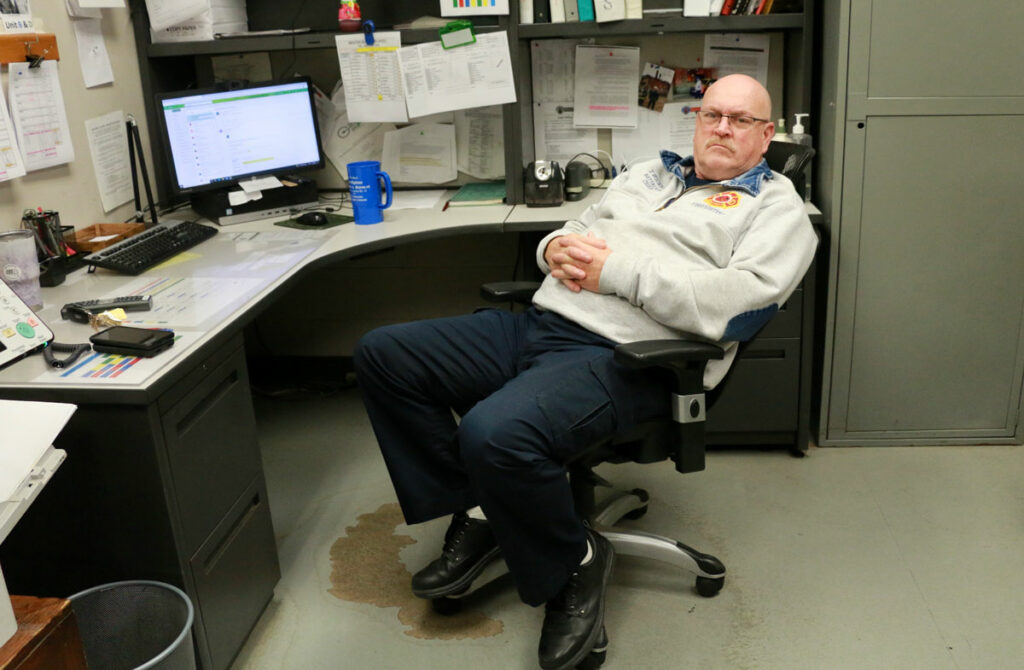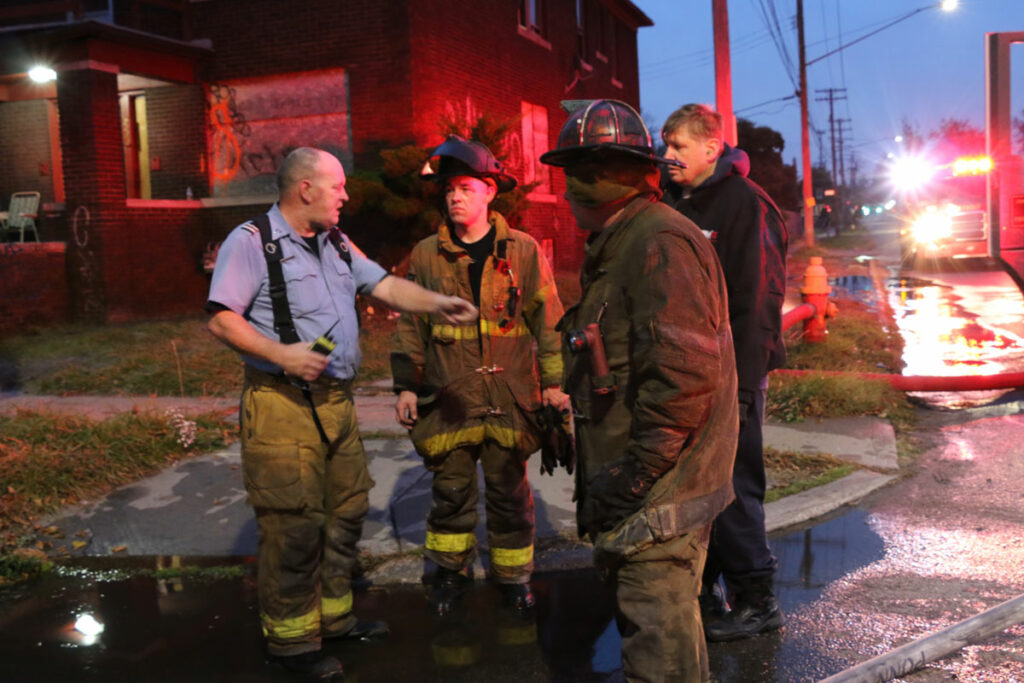A retiring firefighter reflects on change and evolution in an urban fire department

Article and photos by Constance York
Detroit 7th Battalion Chief Thomas Wickman became a firefighter on February 3, 1986. There were 42 people in his class. By the beginning of 2022, just two remained.
If he had counted the fires, they’d be in the thousands, but Wickman didn’t keep a tab. Growing up in the Brightmoor section of the city, he was already desensitized to the fires- he’d seen the smoke of burning homes for years as he did fitness running through his own neighborhood.
“It was normal,” Wickman said. “For me it was normal, because I saw it a lot.”
Almost four decades later, many of those homes are gone. Brightmoor is now part urban-part rural. Partly decayed/partly reborn. The evolution of arson.
In 1984, Detroit became notorious worldwide for the hundreds of fires the city experienced over Devil’s Night and the surrounding days. Less than two years later, Wickman would sign up.
Wickman retired from the Detroit (MI) Fire Department in early 2022. Will he miss it? He won’t miss those 3 a.m. fires in January.
“I have things to do—you won’t see me at Walmart,” Wickman said. He’s an avid outdoorsman, husband, and father to two sons, Stephen and Aiden. “I’m tired. I’ve been doing this for 36-37 years.”
He will miss those medical benefits though. They end at retirement, a consequence of bankruptcy, and if anything they would be his reason to stay if he could. In Detroit, you must retire at 60, aside from a few higher positions.
“Aggressive interior attack firefighting is an intense rush,” he said, but he won’t miss that either. As a chief, he didn’t participate in that anymore, but he did as a firefighter, sergeant, lieutenant, and captain.
He’s been a part of Detroit Fire’s tradition of promotion through seniority, so as a chief with 36 years on, he’s earned his title. He participated in interior attack-style firefighting until November 2016, when he became a chief.
- Are You Properly Recognizing Your Retiring Firefighters?
- Fire Service Retirees: An Often-Forgotten Community
- 10 Things You Will Miss When All is Said and Done
- When is a Firefighter No Longer?
In the last 10 years, Detroit has risen from rock bottom. Wickman was there for most of the busiest years, as well as those tough, neglectful, lean years. Abandoned and vacant homes had been the ammunition keeping the Detroit Fire Department at war, but many of the vacants have either burned down or been torn down by now. This war is far from over, just as in other cities throughout the United States that continue to contend with the dangers posed by abandoned structures.
Wickman has seen company closings in the double-digits.
“We’re down to 70 companies and it was way higher when I came on, “ he said.
Manpower was about 1,500 in 1986. It went down to below 700 at one point in the last decade and now it’s about 900.

Gear and Business
“Having bunker pants was a life-changer,” he said. “We had pull-up rubber boots, and long trench-coat style rubber coats. We had those things forever.”
“I was still on when we had steel tanks. It was like carrying a small Volkswagen on your back when you went into a fire,” he said. “They were heavy. Then we went to composite bottles and they were much lighter. Then we went to an even smaller bottle which was even better. Then the last set of bottles we got are bigger and heavier, still nowhere near as heavy those old steel bottles, but quite a bit heavier than what we used to have when we first switched over to the composite.”
The bigger bottles hold more air. “Why? The longer you’re in (a fire), fatigue sets in, the structure weakens more…what would you rather have?” Wickman ruminated. “Go in there for 10 minutes or have someone say: ‘Hey, I can stay in for 40 minutes.’ You’re going to kill these guys and that’s what’s going on with our overtime right now.”
Wickman said that the younger firefighters don’t realize that working all that overtime will catch up with them at some point, that they’ll pay a price for it, one way or another.
“As far as our new gear, I can’t really speak of our equipment now. I haven’t fought a fire in it,” he said. “But I do know a number of guys have been burned severely wearing that turnout gear.”
Wickman stressed that in the city of Detroit, all safety equipment goes to the lowest bidder. He added that it’s always been that way, and that even though this equipment might meet the criteria of the department, that doesn’t mean it’s the best. During the years preceding bankruptcy, gear was looking pretty bad and was not always available.
“I had to laugh, because it wasn’t until recent years, probably the last decade, that the city said if your gear’s more than 10 years old you gotta get rid of it,” he said. “Back then, it wasn’t an issue, because we wore through it so fast, we were so busy we were going through at least a set every two years or less.”
“We were busy. We were the busiest department, really on Earth,” he said. “If you go by the size of our city, the number of firefighters we had, and the number of fires we had a day—nobody’s ever done that and I pray that no one ever has to again.” Wickman said Detroit had companies running 300 fire calls a month.
His busiest day was July 4, 1987: 24 fires in 24 hours.
One memory he has is of driving in the tactical vehicle, getting on the scene with a dwelling going throughout and being told they had no companies available to send. The fire went from two to three dwellings until a truck arrived.
The Evolution of Detroit Firefighting
Battalion Chief Wickman said that Detroit was one of the first cities to have an aggressive interior attack because of the masks that would allow them to do so.
“Aggressiveness has changed tenfold since when I came on,” he said. “The number of manpower, the homes and buildings have been sabotaged or sat for so long…they become death traps.”
The death of Firefighter Walt Harris had a big impact and was a big motivation for that change. The motivation to not lose another one. On November 15, 2008, Firefighter Walter Patrick Harris Sr., 38, responded to an incendiary fire in an abandoned home. He and several other firefighters were putting out hot spots in the attic when the roof collapsed, trapping the members. Firefighter Harris was crushed by the debris and ultimately died from his injuries. Among other factors cited in the National Institute for Occupational Safety and Health (NIOSH) line-of-duty death report on the incident were the dilapidated building conditions and inadequate risk-versus-reward analysis prior to committing to interior operations in a vacant structure.
“We’ve gotten a lot smarter, but Detroit has been such an aggressive attack, it’s hard to pull the reins back.” Wickman said that at some point, vacants just aren’t safe anymore, and it’s unwise for firefighters to go charging into death traps. “It’s been ingrained in their minds that this is how we do it. And it’s a rush. It’s better than any roller coaster ride you’ll ever go on—there is just something about going in and attacking that fire and putting it out.”
“Back in the day, I asked about getting hired and was told they had 12,000 applications,” he said. “Everybody wanted to do this. Nowadays, I don’t know if you would get 100. It’s changed quite a bit. Some still come and apply with Detroit for the ‘education.’ The majority of our department is still that old-school style and not a lot of people can teach that.”
One way he’d like to see improvement in the department is in treating or understanding those who suffer from post-traumatic stress disorder (PTSD) on the job.
“It’s got to hit you at least a little bit,” he said. “Firefighters have become numb, it goes back to the PTSD. We become cold, or coarse, crass however you want to say it, because we’ve had to deal with it so much. It’s got to get to you. We’ve lost a lot of great people to PTSD and it shouldn’t happen.”
Constance York is a multimedia journalist from Metro Detroit. She has been documenting the Detroit (MI) Fire Department since around 2002. Check out her Facebook page Detroit on Fire and her YouTube channel.

